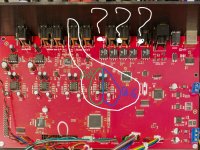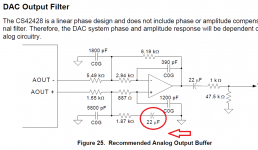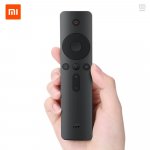Which is the power supply for the op-amps, I want to improve the regulators for lower noise and higher current ones?
I'm happy with the internal DAC at this point. It sounds natural.At this point why not thinking of using external dac boards that give you more room for improvement?
You have space for a second layer of four boards like 9038q2m or whatever you like ;-)
Contrary to what some audiophile says, I think that DAC chips have their own sound signature independent of the output stage design. Of course the output stage does the difference because of its role in buffering the weak output from the chip.The DACs in the NAJDA have the the "typical" CS sound... that I like a lot.
I am a fan of the CS4398 chip and I own three different DACs based on that chip. These DACs go from budget stuff like the Topping D30 to a sophisticated unit with state-of-art regulated psu + output tube stage + tube psu. All of them have a sort of low-level sound fingerprint which I also feel listening music from the NAJDA used as a single-channel DAC on my passive 2ch secondary system.
I am a fan of the CS4398 chip and I own three different DACs based on that chip. These DACs go from budget stuff like the Topping D30 to a sophisticated unit with state-of-art regulated psu + output tube stage + tube psu. All of them have a sort of low-level sound fingerprint which I also feel listening music from the NAJDA used as a single-channel DAC on my passive 2ch secondary system.
Contrary to what some audiophile says, I think that DAC chips have their own sound signature independent of the output stage design.
Would be nice to have objective verification - too many audiophiles "feel" all kinds of stuff, starting with "audio-grade" fuses and magic crystals...
Can you guys help me with the capacitors for the op-amps?...
The use of the 4 remaining opamps is as follows:
...
- The one near the PCB edge is for ch. 3&4
- The next one for ch. 1&2
- The next one for ch. 7&8
- The last one for ch. 5&6
Are one side of them for one channel and the other pair for the other channel?
I hope this photo will make clear my question?
I want to put different values for different channels.
Attachments
Replaced the caps with Jantzen. I'm with mixed feelings.
There was a problem with the tweeter (maybe too low value /0,82uf/ ???) - I had to increase the delay from 24 samples to 280 in order to match the same time alignment !!!



There was a problem with the tweeter (maybe too low value /0,82uf/ ???) - I had to increase the delay from 24 samples to 280 in order to match the same time alignment !!!
^ Update on the above problem - the reason for the delay was the mixing of 511 sample filters on the tweeter channels in combination with the rest of 1023 samples.
Subjective differences in comparison with stock caps include:
The negative effects create a feeling of not enough powerful power supply.
What could be the reason for that?
I'm gonna put caps across the Vin pins of the op-amps - any recommendations?
Subjective differences in comparison with stock caps include:
- + Much tighter bass (like switching from a big heavy woofer to a smaller lightweight one)
- + Bigger micro-dynamics - more layers and smoother textures
- + More natural timbre in regards to voices and acoustic instruments
- + Less sibilance and grain, especially at higher frequencies.
- ± Much more relaxed sound - On one hand it is relaxed such as the aggression disappeared. However, I feel that overall attacks have a lower impact - It's as if the peaks don't reach the same volume as before.
- - Lower macro-dynamics - check the above point.
- - Less enthusiasm in the vocals - they are "whatever" - check the above points.
The negative effects create a feeling of not enough powerful power supply.
What could be the reason for that?
I'm gonna put caps across the Vin pins of the op-amps - any recommendations?
Last edited:
Interesting.^ Update on the above problem - the reason for the delay was the mixing of 511 sample filters on the tweeter channels in combination with the rest of 1023 samples.
Subjective differences in comparison with stock caps include:
- + Much tighter bass (like switching from a big heavy woofer to a smaller lightweight one)
- + Bigger micro-dynamics - more layers and smoother textures
- + More natural timbre in regards to voices and acoustic instruments
- + Less sibilance and grain, especially at higher frequencies.
- ± Much more relaxed sound - On one hand it is relaxed such as the aggression disappeared. However, I feel that overall attacks have a lower impact - It's as if the peaks don't reach the same volume as before.
- - Lower macro-dynamics - check the above point.
- - Less enthusiasm in the vocals - they are "whatever" - check the above points.
The negative effects create a feeling of not enough powerful power supply.
What could be the reason for that?
I'm gonna put caps across the Vin pins of the op-amps - any recommendations?
Could there be some middle ground / best of both worlds sound wise?
I've got big Burson op amps in, so would need to get smaller caps or arrange them further away somehow.
Hmm, I was thinking of removing all caps and bridging them? Best cap = no cap.Interesting.
Could there be some middle ground / best of both worlds sound wise?
I've got big Burson op amps in, so would need to get smaller caps or arrange them further away somehow.
Is it possible for the Burson op-amps to have 0 DC output? If yes, then the capacitors are not needed?
I've put 100nf caps on the opamps and after a day of use, I can conclude that there is a consistent perceivable step-up in dynamics and overall snappiness of the sound. A touch more air and overall the music is slightly more engaging.



I'll be careful on that, at least the way you did. Top/closer to RCA caps are in signal path. But those below opamps are power decoupling (one for + and other for -). If you short then then well you will short power supply.Hmm, I was thinking of removing all caps and bridging them?
On the other hand I'm not sure if they are power supply capacitors but anyway one leg is on GND so at least there will be some short in signal path.
.....
Ok I was wrong, that is the cup. But question is if it's worth to touch it?
Attachments
Last edited:
What IR Remote controls are you using? Mine just died. I don't wont simple one like Apple TV. I want to be able to select any of 9 configs directly (or at leas some of them) and directly to select Najda's input. On the other hand too many buttons are just messy and not needed.
And what are conditions for remote to be handled by Najda. I tried to configure Xiaomi TV Box remote but Najda does not see it.
So what were your choices?
And what are conditions for remote to be handled by Najda. I tried to configure Xiaomi TV Box remote but Najda does not see it.
So what were your choices?
Attachments
Last edited:
I use a cheap all 4 one remote.What IR Remote controls are you using? Mine just died. I don't wont simple one like Apple TV. I want to be able to select any of 9 configs directly (or at leas some of them) and directly to select Najda's input. On the other hand too many buttons are just messy and not needed.
And what are conditions for remote to be handled by Najda. I tried to configure Xiaomi TV Box remote but Najda does not see it.
So what were your choices?
Like this or previous model.
Can programme each of the source selects in and scroll through the presets etc.
It's also been going for 9 years!
Probably not, there are some parts of it inside thread, mostly because where based on default circuits for specific chip.Does anyone have a circuit schematic for Nadja?
Something broke with yours?
Hi,
Do you guys are using bass/treble function ?
I'm a DIYer & 'F. Toole' enthousiast and i'd like to use this function.
But I can't activated it without having the dedicated 'bass/treble clipping" led flashing quasi-continuously.
Even if I set the maximum headroom and set bass & treble at 0.
So I'm using 3/4 presets with some high-shelf values, but it's not as easy as it could be with a bass/treble knob 🙁
Is this a bug ? Do I need to save / reboot / etc the najda in order to correct this problem ?
Do you guys are using bass/treble function ?
I'm a DIYer & 'F. Toole' enthousiast and i'd like to use this function.
But I can't activated it without having the dedicated 'bass/treble clipping" led flashing quasi-continuously.
Even if I set the maximum headroom and set bass & treble at 0.
So I'm using 3/4 presets with some high-shelf values, but it's not as easy as it could be with a bass/treble knob 🙁
Is this a bug ? Do I need to save / reboot / etc the najda in order to correct this problem ?
You need to put proper attenuation for the signal to give this functions room for work. best would be to attach screenshots of your configs here.
Thanks for the reply.Probably not, there are some parts of it inside thread, mostly because where based on default circuits for specific chip.
Something broke with yours?
Yes, my original board was fed +5V polarity swapped.
The diode, or is it inductor went up in smoke!
With that bypassed, as Nick suggested (this was a few years ago).. when hooked up to the PC SW, the processor view was glitchy and showing overload on the right one all the time / not responding.
Someone wants to take it on for free and try to repair it, so I'm fishing for helpful info.
For me it was showing strange overload on one channel when I burned opamp on adc input. You can try to remove it and check if this helped.
On another occasion I burned S/PDIF receiver, but Toslink or analog was working fine. You can test all inputs and see it this applies to all of them.
Some time ago I also did same thing with swapped polarity. Replacing inductor helped.
It was Murata LQH43MN220K03L
https://www.mouser.pl/ProductDetail/Murata-Electronics/LQH43MN220K03L?qs=rMxjHOpQ3awDvVQWZYQ/QQ==
On another occasion I burned S/PDIF receiver, but Toslink or analog was working fine. You can test all inputs and see it this applies to all of them.
Some time ago I also did same thing with swapped polarity. Replacing inductor helped.
It was Murata LQH43MN220K03L
https://www.mouser.pl/ProductDetail/Murata-Electronics/LQH43MN220K03L?qs=rMxjHOpQ3awDvVQWZYQ/QQ==
Thanks that's useful.For me it was showing strange overload on one channel when I burned opamp on adc input. You can try to remove it and check if this helped.
On another occasion I burned S/PDIF receiver, but Toslink or analog was working fine. You can test all inputs and see it this applies to all of them.
Some time ago I also did same thing with swapped polarity. Replacing inductor helped.
It was Murata LQH43MN220K03L
https://www.mouser.pl/ProductDetail/Murata-Electronics/LQH43MN220K03L?qs=rMxjHOpQ3awDvVQWZYQ/QQ==
I'll pass that on.
I'll keep this place updated, as the board repair attempt progresses.
- Home
- Source & Line
- Digital Line Level
- DSP Xover project (part 2)


